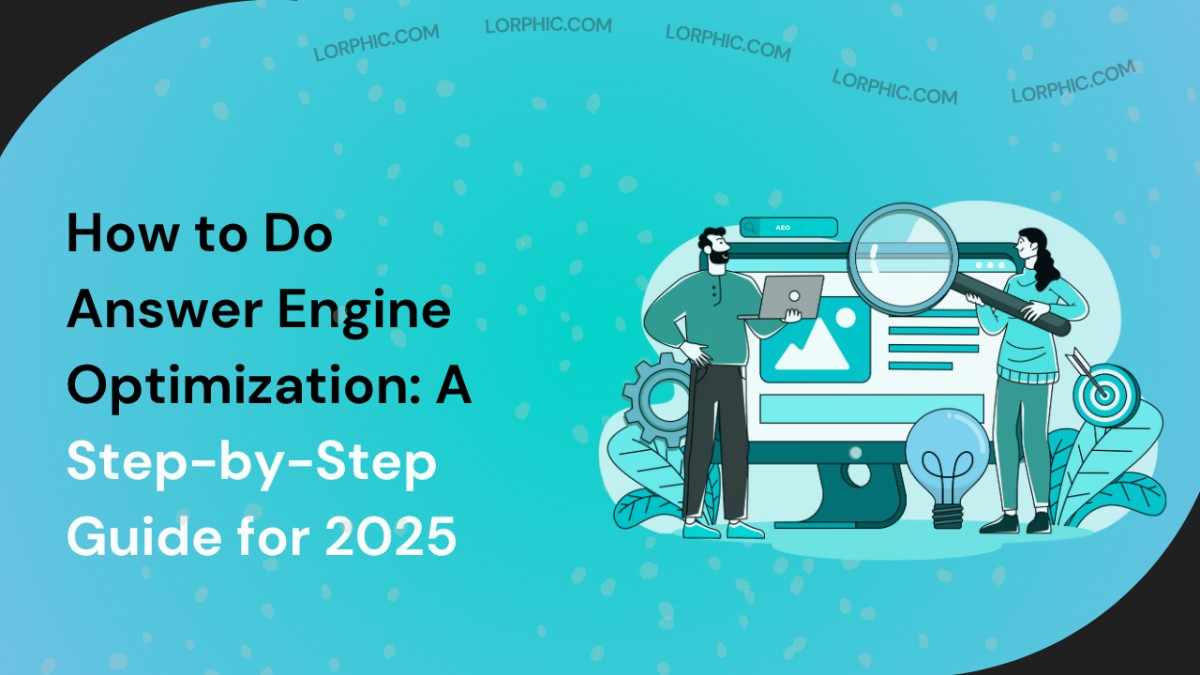Search is evolving. For years, we’ve counted on search engines to provide us with a list of links and hoped we’d be able to find the answers ourselves. But today, with the emergence of AI chatbots and sophisticated search algorithms, users want direct answers. That’s the change that represents the shift from Search Engine Optimization (SEO) to Answer Engine Optimization (AEO). This guide will take you through precisely what AEO is and give you a step-by-step process on how to do Answer Engine Optimization.
Rather than shooting for the number one position on a list page, AEO is concentrated on creating the best single answer to a user’s query. That content is then leveraged to fuel AI-powered search results, such as Google’s AI Overviews, and chat responses from platforms like ChatGPT and Perplexity. Doing it right makes your brand the immediate source of truth for your audience.
Understanding Answer Engine Optimization
Answer Engine Optimization, or AEO, is the process of shaping your content so that artificial intelligence powered search engines can easily read, understand, and use it to provide direct and accurate answers to people’s questions. It can be seen as the natural next step after traditional SEO. While SEO focuses on helping web pages appear higher in search results, AEO is all about making your content the actual answer that appears in AI summaries, voice searches, and chatbot responses.
This matters because the way people search for information is changing. Instead of typing short keywords, users now ask complete, conversational questions and expect quick, reliable answers. According to experts, by 2026 traditional search engine use will drop by 25 percent, with more people turning to AI chatbots and virtual assistants.
By optimizing for answers today, your brand can stay visible and relevant in this evolving landscape. AEO helps build trust, improve user experience, and ensure your business remains a go to source of information as search technology continues to advance.
Step-by-Step Guide On How to Do Answer Engine Optimization in 2025?
Optimizing for answer engines requires a specific, structured approach. Here’s how you can get started.
1. Identify User Questions and Intent
The first and most important step in Answer Engine Optimization is understanding exactly what your audience wants to know. Instead of focusing only on general keywords, try to uncover the real questions people are asking online or through voice assistants.
- Use Research Tools: Platforms like Semrush, Ahrefs, and AlsoAsked help you discover the most common questions people ask, including “how,” “what,” “why,” and “where” queries. These insights reveal the real intent behind user searches and help you create content that answers them directly.
- Study Your Own Data: Check your website’s search bar, customer service chats, and social media messages to find recurring questions or concerns. These reflect genuine user needs that you can address through your content.
- Learn from Competitors: Observe what questions your competitors are answering and how they appear in featured snippets or AI-generated summaries. This helps you identify gaps in your content strategy and new opportunities to stand out.
2. Create Clear, Concise, and Authoritative Content
After identifying your audience’s key questions, the next step is to craft content that delivers straightforward and trustworthy answers. Answer engines prioritize content that is easy to understand, accurate, and credible.
Start with the Answer: Open your section by giving a direct, clear answer to the main question. Then, expand on it with supporting details, examples, or explanations. This helps both users and AI quickly grasp your key point.
Keep It Simple: Write in a conversational, easy-to-read style. Aim for short sentences and plain language that anyone can understand. Avoid unnecessary technical terms or fluff that might confuse readers.
Show Expertise and Build Trust: Support your statements with credible data, expert opinions, or research findings. Linking to trusted industry sources or studies, such as Nielsen Norman Group’s research on user behavior, helps establish your authority and signals to AI models that your content is reliable.
By combining clarity, simplicity, and credibility, you create content that resonates with users while ranking higher in AI-powered search results.
3. Structure Your Content for Machines
Answer engines and AI models rely on structure to understand and extract information accurately. Well-organized content not only improves readability for users but also helps AI identify the most relevant answers.
- Use Headings and Subheadings: Break your content into clear sections using H1, H2, and H3 tags. Each heading should align with a specific question or topic so that both users and AI can easily follow your message.
- Use Lists and Tables: Present information in bullet points, numbered lists, or simple tables. This makes it easier for AI systems to scan and extract key data, such as steps, comparisons, or definitions.
- Add Schema Markup: Schema markup is a behind-the-scenes code that helps search engines understand your content. For AEO, use structured data types like FAQPage, HowTo, and QAPage to highlight question-and-answer sections. This increases your chances of appearing in AI summaries or voice results.
4. Optimize for Featured Snippets
Featured snippets are the short, highlighted answers that appear at the top of Google search results, often serving as the foundation for AI-generated responses. Securing these positions can dramatically boost your visibility and credibility.
Target Questions with Snippets: Focus on queries that already display featured snippets in search results. These are strong indicators of what Google and AI platforms see as “answer-worthy” content.
Create Snippet-Ready Content: Write a short, clear paragraph—around 40 to 50 words—that directly answers the question. This serves as your “snippet bait,” giving search engines exactly what they need to showcase your answer.
Use the Right Format:
- Paragraph Snippets: Provide a concise and direct answer to the question.
- List Snippets: Use bullet points or numbered steps for how-to guides or lists.
- Table Snippets: Present comparisons or data using simple tables to make extraction easier for AI.
Additional Tips for Successful AEO in 2025
To truly succeed with Answer Engine Optimization in 2025, it’s important to go beyond the basics. As AI-driven search continues to evolve, small improvements in accessibility, freshness, and authority can make a big difference in visibility.
Prioritize Mobile Experience: Most conversational searches now happen on mobile devices. Make sure your website loads quickly, is easy to navigate, and delivers a seamless user experience across all screen sizes.
Adapt to Voice Search: People use natural, conversational language when speaking to voice assistants. Optimize your content by including question-based phrases and long-tail keywords that reflect how users actually talk.
Keep Your Content Fresh: Regularly update your articles, data, and examples to stay relevant. AI answer engines favor current, reliable information when deciding which answers to display.
Build Topical Authority: Instead of writing standalone posts, create clusters of related content around your main subjects. This approach helps search engines and AI models view your brand as a trusted authority in your niche.
How AEO Differs From Traditional SEO?
While both Answer Engine Optimization (AEO) and Search Engine Optimization (SEO) aim to increase online visibility, they take very different paths to achieve it. SEO focuses on getting users to click through to your website, whereas AEO focuses on making your content the direct answer that AI systems and search engines display.
| Feature | Traditional SEO | Answer Engine Optimization (AEO) |
| Primary Goal | Rank web pages higher in search results to drive clicks and traffic. | Provide direct, authoritative answers that appear in AI summaries and voice search responses. |
| Keyword Focus | Targets short-tail and long-tail keywords to match search intent. | Focuses on conversational and question-based queries that mirror how users speak. |
| Content Strategy | Uses long-form, comprehensive content to cover topics in depth. | Prioritizes short, factual, and structured answers optimized for AI and snippets. |
| Success Metrics | Measures performance through organic traffic, keyword rankings, and click-through rates. | Success is defined by featured snippet appearances, “Position Zero” results, and AI visibility. |
| Approach | Designed for human readers browsing search results. | Designed for AI models and voice assistants to extract and present accurate answers. |
Final Thoughts
The shift from search engines to answer engines represents more than just a change in algorithms, it’s a fundamental transformation in how people discover and consume information. Users no longer want to browse through multiple links; they expect clear, reliable, and instant answers. For brands and marketers, this means it’s no longer enough to just “rank”, you need to be the answer.
By focusing on Answer Engine Optimization (AEO), you position your business for long-term success in an AI-driven search environment. When you create structured, trustworthy, and easy-to-digest content, you make it easier for AI models, like Google’s Search Generative Experience (SGE), ChatGPT, and Perplexity, to recognize your expertise and feature your content as the definitive source.
Think of AEO as the next phase of SEO, not a replacement, but an evolution. Together, they help ensure your content remains visible whether users are searching traditionally, asking a voice assistant, or getting instant answers from AI chatbots.
As we move deeper into 2025 and beyond, brands that adapt early will not only maintain visibility but also earn trust and credibility in an increasingly intelligent digital world. So start optimizing for answers today , because tomorrow’s search experience has already begun.




